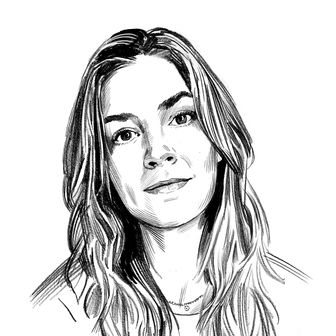
Dylan Farrow has been telling the same story since she was seven years old: One afternoon in 1992, she says her adoptive father, Woody Allen, brought her to the attic of her mother, Mia Farrow’s, Connecticut home and — out of sight of the rest of the family — molested her. In the intervening three decades, her account has not faltered. It has remained consistent since she first shared it with therapists, then police, as a child; when she aired it in a New York Times op-ed in 2014, and in the Los Angeles Times in 2017, in a televised interview with CBS in 2018, and now, in a four-part documentary from HBO: Allen v. Farrow, an exhaustively detailed investigation into the abuse allegations and subsequent custody battle that kneecapped Farrow’s career and have only recently begun to create consequences for Allen.
Allen has always adamantly denied Dylan’s allegations. He did not return interview requests for the documentary and described it after the fact as a “hatchet job riddled with falsehoods” and a “shoddy hit piece.” His public statements have followed the same formula since the early ’90s: He maintains that Farrow, his former partner of 12 years, orchestrated a smear campaign after discovering his affair with her 21-year-old adopted daughter, Soon-Yi Previn, and coached Dylan through a false allegation of sexual assault. “I never molested my daughter,” he said in the wake of Dylan’s 2018 interview with CBS, “as all investigations concluded a quarter of a century ago.”
All of this information has been public for decades; what Allen v. Farrow does is to present it in a way that centers Dylan’s perspective. Documentarians Amy Ziering and Kirby Dick — along with investigative journalist Amy Herdy — comb through a staggering mountain of evidence, much of which is new to the public. They undertook extensive interviews with Dylan, Mia, and Ronan Farrow (Dylan’s brother, and the Pulitzer Prize–winning New Yorker journalist who helped break the story of the allegations against Harvey Weinstein) along with a number of Mia’s biological and adoptive children, close friends of the family, the Connecticut prosecutor who oversaw the case, journalists, and a raft of psychological and legal experts. They surfaced home videos and covertly recorded calls between Farrow and Allen. They went through court documents, police files, and social workers’ case notes, all of which suggest a single conclusion: Money and power can silence a credible witness.
Below, the biggest takeaways from Allen v. Farrow.
Allen’s behavior toward Dylan struck outside observers and family friends as inappropriate.
According to Mia Farrow, Woody Allen had no interest in meeting her seven children (three biological, four adopted) when the pair began dating in 1980. Still, when she decided, a few years into their relationship, that she wanted to have children with Allen, both say (the documentary includes segments of his autobiography, Apropos of Nothing) he agreed — on the condition that he could involve himself as little as he wanted. But according to Mia, he also told her he “might be more kindly disposed if it was a little blonde girl,” and so she adopted Dylan in 1985. (Allen adopted Dylan in 1991.)
Quickly, Allen — by his own account and Mia’s — developed an unsettling interest in Dylan. According to Mia’s other children, people close to the family, and even one a psychiatrist who lived in Mia’s building and happened to spot Dylan and Allen one day, Allen’s doting bordered on obsession. He allegedly worked to silo her from the rest of the family, with a focus so single-minded that even a therapist of Allen’s deemed it “inappropriately intense.”
“I was always in his clutches,” Dylan recalls in an interview. “He was always hunting me.” She remembers instances in which Allen would “direct” her on how to suck his thumb, “telling [her] what to do with [her] tongue.” She says he would cuddle her in bed, envelope her with his whole body while wearing nothing but his underwear. One family friend, Priscilla Gilman, says she witnessed both of those moments, while other family members and acquaintances attested to Allen’s sexually suggestive handling of Dylan.
“I felt more like a policeman, coming in like, Am I going to see something that shouldn’t be happening?” Mia said, explaining how Dylan began to shut down or hide from Allen whenever he came around — a behavioral change numerous other people confirmed in interviews.
Allen, again, has repeatedly denied anything untoward. In a contemporaneous interview with 60 Minutes, a portion of which plays in the documentary, he posits that it simply wouldn’t make sense for pedophilic tendencies to suddenly surface in a 57-year-old man. “If I had wanted to be a child molester,” he notes, “I’ve had many opportunities in the past.”
Allen’s sexual relationship with Soon-Yi may have started when she was still in high school.
The official story on Allen’s relationship with Soon-Yi, one of Mia’s adopted children, holds that their sexual relationship didn’t begin until she was 21 years old and in college. Allen v. Farrow proposes a different timeline: Mia says she found out about Soon-Yi and Allen in 1992, when she discovered a stack of sexually explicit Polaroids in his apartment. In an interview, Mia says she subsequently spoke with doormen in Woody’s building and his maid, who told her Soon-Yi had “been coming there for a long time,” previously arriving in her high school uniform.
“The maid would change the bed after she left,” Mia says. “The maid told me about the condoms in the wastebasket and the sheets that needed changing, all of that.” His doorman, building manager, and housekeeper reportedly confirmed all of this in court testimony.
For her part, Soon-Yi told Newsweek in 1992 that she wasn’t some “little underage flower who was raped, molested, and spoiled by some evil stepfather.” She remains married to Allen: The couple have adopted two children together, and Soon-Yi has always stood behind Allen’s narrative. “What’s happened to Woody is so upsetting, so unjust,” she told New York in 2018, having granted a rare interview to a decades-long, sympathetic friend of her husband. “[Mia] has taken advantage of the #MeToo movement and paraded Dylan as a victim.”
The psychologists appointed to analyze Dylan delivered a suspicious report.
In order to determine whether or not Dylan was fit to testify in court, Connecticut prosecutor Frank Maco commissioned the Yale–New Haven Child Sexual Abuse Clinic to evaluate her. Under the leadership of clinic director Dr. John Levanthal, social workers Dr. Julia Hamilton and Jennifer Sawyer interviewed Dylan nine times about her experience with Allen in the attic — a number the documentary’s three independent experts in child psychology consider ludicrously high. Upon reviewing the report, all of them, along with Maco, found her description of events to be consistent and credible. Unfortunately, the clinic destroyed the social workers’ notes on the interviews instead of turning them over to investigators — a practice that the documentary’s experts uniformly described as tantamount to destroying evidence.
Maco says the clinic called him to let him know that they found Dylan “unreliable, untrustworthy, and/or, that Mia Farrow was a fabricator of this incident” shortly after it delivered the news directly to Allen — the suspect in the case — and Mia. The clinic also allowed Allen to announce in a press conference on the clinic steps that he had been “cleared.” But clearing a suspect of charges is not a power the Yale–New Haven Child Sexual Abuse Clinic holds; that power rests with the prosecutor’s office.
As a prosecutor, Maco felt he had “probable cause” to charge Allen.
Maco never wound up bringing charges against Allen but always felt he had probable cause to do so. Maco told the filmmakers about his own meeting with Dylan and how she became “totally unresponsive,” with “a glazed look over her eyes,” when he brought up “Daddy Woody.” Maco says he chose not to pursue charges because believed that putting Dylan on the stand — as the trial would require — would, as he put it at the time, risk “further traumatization” of a child “who had already been through so much.” In other words, Allen didn’t escape trial because Connecticut lacked evidence to charge him; Allen escaped trial because the state prosecutor feared for the victim.
NYC social workers investigating the case believed Dylan and thought she had “more to disclose.”
Meanwhile, New York’s Child Welfare Administration was also investigating the claims against Allen. Within two weeks, case worker Paul Williams reportedly concluded that he had sufficient information to open a criminal investigation against Allen. He was reportedly told that “it is customary for the ‘big wigs’ to take over in high-profile cases.” Williams, who did not give an interview in the documentary, temporarily lost his job in what his attorney described as a “massive coverup attempt” by the mayor’s office to keep Williams from sharing his findings. That attorney claimed the city waged a campaign to “suffocate and silence” the case worker, who is seen in vintage news footage saying, “I believe the kid.” Williams subsequently (and successfully) sued the city to regain his post.
In reviewing the CWA files, however, filmmakers noticed a compelling detail: Williams had spoken directly with Jennifer Sawyer, one of the two social workers who evaluated Dylan at the Yale-New Haven clinic. In his notes — which, again, are the only ones available, as Yale–New Haven destroyed theirs — Williams wrote that Sawyer “indicated that she believes Dylan,” and was actually “of the opinion that the child has more to disclose.”
The judge in Allen’s custody lawsuit concluded that his behavior toward Dylan was “grossly inappropriate.”
From the beginning, Allen’s defense — as he explained it on 60 Minutes — held that Mia became enraged over his relationship with Soon-Yi and poisoned Dylan against him. When he decided to sue her for custody of Dylan, Ronan, and Moses in 1992, he did so on the grounds that she had become an unfit mother — “emotionally disturbed,” heavily medicated, “unable to manage the rearing of her nine children,” whom Allen said she was also “brainwashing.” His argument aligned tidily with a controversial theory advanced by child psychiatrist Richard Gardner: Parental Alienation Syndrome, which (according to Gardner’s personal experience; his self-published work on the subject had no scientific basis and was never peer-reviewed) occurs when one parent tries to win their children’s allegiance by disparaging and even lying about the other parent during divorce proceedings. Gardner believed this was particularly true where sex-abuse allegations were concerned and shared that opinion freely in the media during Allen and Farrow’s custody battle.
But during the actual hearing, one babysitter who’d been looking after Mia’s children on the day of the alleged assault recalled walking in on Allen with his face buried in Dylan’s crotch. Two others confirmed that he then disappeared with Dylan for 20 minutes. According to reporters who covered the hearing, Allen appeared meek in his defense; meanwhile, Mia’s video recordings of Dylan (also featured in the documentary) explaining what had happened to her contradicted the idea that she had coached or led her daughter to a particular narrative. In the end, the judge ruled in favor of Mia, stating that “Mr. Allen’s behavior toward Dylan was grossly inappropriate,” and that “measures must be taken to protect her.” He deemed the Yale–New Haven report “sanitized” and questioned whether or not Allen could ever become a fit parent to his daughter. Allen’s two subsequent appeals were denied.





